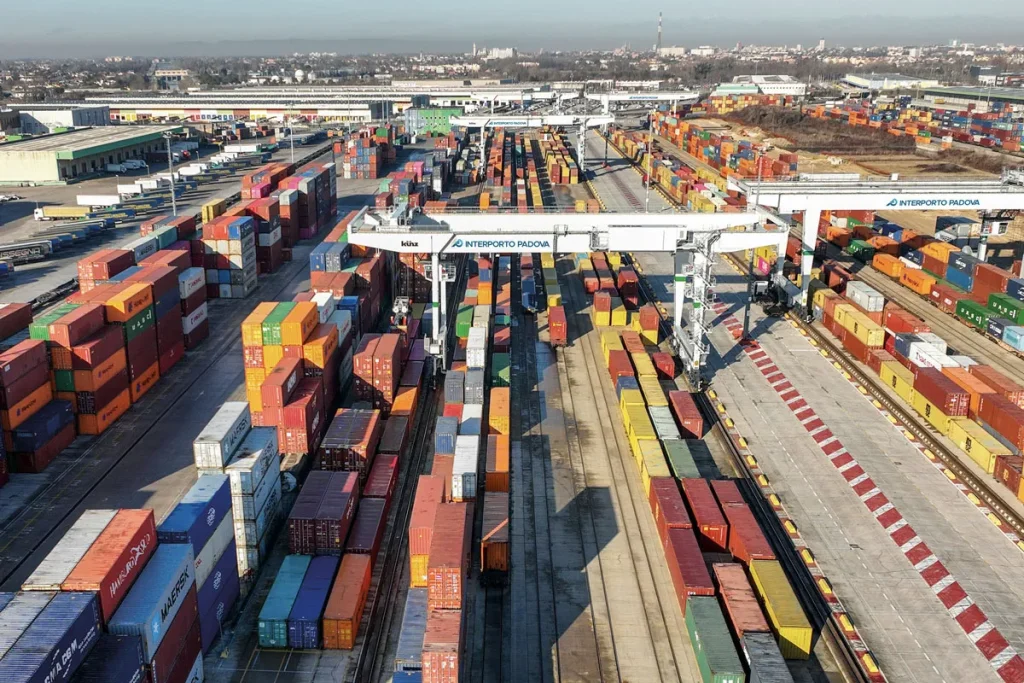In the context of European intermodal logistics, the Padua Dry Port stands out as an example of excellence in digital transformation, environmental sustainability, and operational resilience.
As a core node in the TEN-T network, which connects the main European freight corridors, Padua has seized recent challenges, innovating its infrastructure and services to offer companies more efficient, flexible, and sustainable logistics solutions.
Digitalization and Automation: The Foundations of Transformation
The recent success of the Padua Dry Port is the result of a clear technological innovation strategy. Some of the most significant initiatives include:
- 750-meter tracks – ideal for accommodating longer freight trains and optimizing operational cycles.
- Six electric gantry cranes, largely powered by photovoltaic systems with storage batteries.
- Automated truck gates, reducing loading/unloading times to less than 30 minutes.
- Remote crane operation experiments, improving safety and precision.
These solutions have made the dry port not only more productive but also more sustainable, significantly reducing energy consumption and emissions.
Intermodality as a Response to Global Crises
In a period characterized by geopolitical instability—from the pandemic to the Suez Canal crisis—the Padua Dry Port has strengthened its network, extending rail connections beyond Italian ports to strategic terminals in Central Europe, Poland, and Eastern Europe.
This strategy allows for:
- Diversification of traffic routes
- Logistics continuity even in the event of maritime route disruptions
- Making rail intermodality a concrete tool for Italian exports
This forward-looking choice underscores the importance of flexibility in modern logistics models.
Renewable Energy and Investments for the Future
Energy transition is another pillar of the Padua hub’s development:
- Two photovoltaic systems power a significant portion of its operations.
- The attraction of new international logistics partners demonstrates the growing appeal of the facility.
With over 15 MW of installed capacity and ongoing expansion projects, the Padua Dry Port stands out as a virtuous model in the field of energy sustainability.
An Example for Italy and Europe
According to recent estimates, the logistics sector today represents 11-12% of the European GDP, and its impact in Italy is expected to grow, exceeding €140 billion by 2030.
In this scenario, experiences like that of the Padua Dry Port provide a clear roadmap for:
- Integrating technological innovation and intermodality
- Reducing environmental impact
- Improving the international competitiveness of Italian companies
PortaleGenio: Supporting the New Intermodal Logistics
In the context of intermodal logistics transformation, PortaleGenio serves as a valuable information tool for companies and operators seeking to explore new sustainable transport opportunities.
Through a simple and intuitive representation of the European intermodal network, PortaleGenio allows users to:
- Visualize detailed connections between terminals, ports, and dry ports
- Access dynamic data on over 1,200 rail connections and 360 Ro-Ro lines
- Explore alternative routes to all-road transport, contributing to a more resilient and sustainable logistics system
With a dedicated space exclusively for dry ports and the possibility to access technical and thematic insights through its blog, PortaleGenio presents itself as a valuable tool for tackling the challenges of logistics modernization.
Conclusions
The example of the Padua Dry Port demonstrates that it is possible to combine technology, intermodality, and sustainability in a virtuous way.
In the context of an increasingly demanding Logistics 4.0 environment, information tools like PortaleGenio help operators navigate these ongoing transformations with awareness, supporting the construction of a more connected, efficient, and environmentally friendly logistics future.
Sources:
- Updated sector data (2024) on logistics and European GDP (Mordor Intelligence, European Commission Reports)
- TEN-T network insights and Italian intermodality initiatives
- Updated operational information from the Padua Dry Port (official and public sources)

